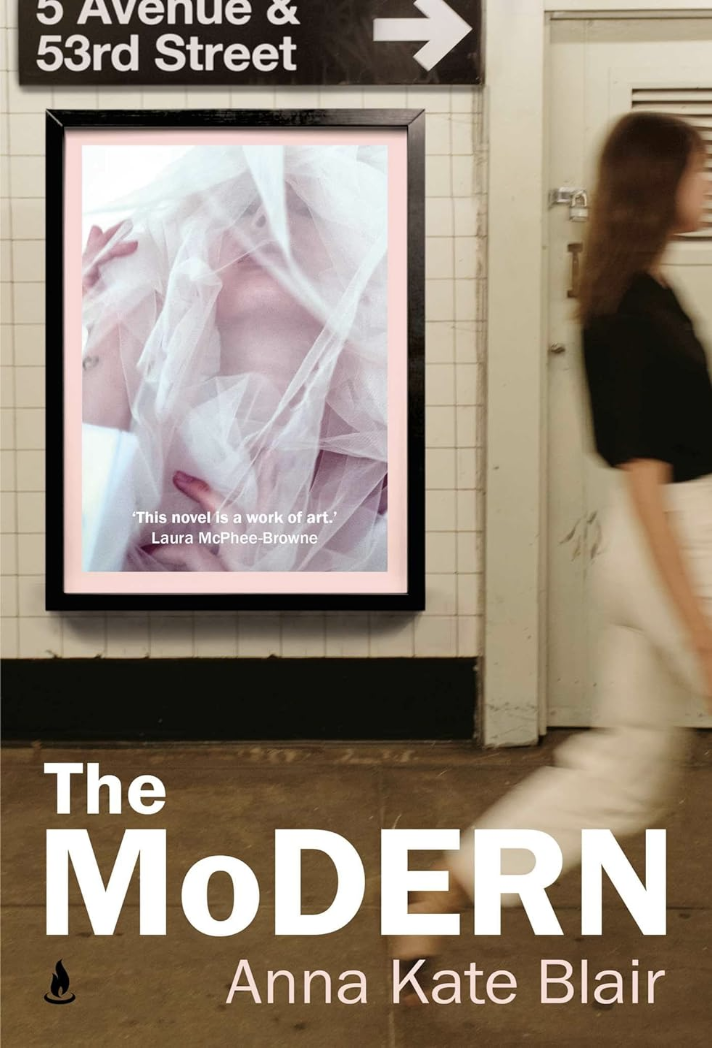The Modern by Anna Kate Blair
The question of what it means to be modern is at the heart of Anna Kate Blair's debut novel The Modern (2023): but will becoming 'modern' make things better, or will nothing really change? Perhaps being modern is, as the narrator Sophia suggests, a type of disenchantment. This feeling is woven deep into the novel, with its shrewd reflections on our questioning, disillusioned world.
Told through the perspective of Sophia – an almost-thirty-year-old Australian living in New York with Robert, her boyfriend of five years – the novel is quite introspective, with Sophia’s day-to-day life acting as a backdrop for musings on sexuality, relationships, work, place and people, and their connection to her world’s nucleus: art.
Sophia is soon to complete her fellowship at the Museum of Modern Art. Just before Robert leaves to hike the Appalachian Trail, Robert and Sophia become engaged, but Sophia’s lack of hesitation in saying “yes” is at complete odds with her uncertain feelings towards marriage, Robert himself, what she imagines her future to be like and how she wants to be perceived.
Due to her inability to “articulate anything” about her life and feelings to him, we are made aware of certain dissonances between Sophia and Robert. His great love is hiking; Sophia finds this “boring.” However, it isn’t their conflicting interests that characterise their doomed relationship, but Sophia’s primary preoccupation:
“I spent a lot of time, at the Museum of Modern Art, thinking about what modern meant … I started to pose questions around this formula. Are Clothes Modern? became Are houses modern? and Are children modern … it was always with me, a frame through which I considered the world … I thought of myself, again and again, because there was no way of avoiding the obvious question: was I modern?”
Sophia comes across as rather ingenuine, “concerned with other peoples’ opinions,” and continuously puts up a facade of someone she would like to be, but in fact is not. This sense of detachment permeates the whole novel; there is a barrier between Sophia and the rest of her world that she never manages to fully overcome. Even with her favourite artist, Grace Hartigan, to whom she makes continual references, Sophia admits: “I couldn’t give myself over to her.” The way Sophia withholds herself from people and experiences is so absolute it extends beyond the story; there is a kind of fog hanging over everything in Sophia’s life, partly obscuring it from the reader’s view. Her female relationships fall somewhat flat, never developing beyond what comes across as a show of friendship, rather than any genuine connections, and ironically it is when describing Grace that Sophia feels most authentic.
Shortly after Robert leaves for his hike, Sophia meets Cara, a young aspiring artist for whom Sophia develops a desire that borders on obsession. Sophia continually returns to Instagram to express herself: the measure of her daily worth is dependent on whether or not Cara has double-tapped her latest post, which is somewhat depressingly reflective of modern life.
Affluent, intelligent and privileged, Sophia could be the 21st century embodiment of wallowing Mrs Dalloway. Apart from a brief reference to past trauma concerning her mother, (the novel is also dedicated to “motherless girls”) we are never given any explanation as to why Sophia is so unable to emotionally connect. Maybe she is simply a bit of a whinger, or rather, like her friend Lucy describes Cara, “kind of self-obsessed.” However, with the tendency for solipsism in our hedonistic, consumerist, me-me society, Sophia acts as a much-needed nudge for critical self-reflection.
It got to the point where I was cheering for Robert when he finally ditches her (sorry, spoiler alert: although I think we can see this coming from the start) because of her inability to commit to anything substantial. Ironically, though she has entertained the idea of leaving him more than she attempted to work on the relationship, Sophia is devastated, but again her reaction is surface-level and cliché: “I thought I was special, but I was not.” She wallows for a few days in her self-termed “histrionics” before reminding herself she “hadn’t wanted Robert, anyway.” Her desperation to find her place – to discover who she truly is and where she could exist freely, happy and loved, may be poignant, but ultimately unattainable due to her passion for art, which for her will always come first.
“I missed feeling like there was a place for me in the world, though I knew I’d never felt like this at all.”
The Modern serves as a disenchanting portrait of modern detachment and the struggle to experience true, deep connection, be it with art, people or ourselves. If this is what being “modern” involves, I’ve got my fingers crossed that being “old-fashioned” is at least slightly more desirable.
Read our interview with the author here!
Martha is a neuroscience and literature student from Warrane. Her time is happily spent peering down microscopes and drafting her first novel. She is a lover of stories and astrocytes, and big green fields. You can find her at mdavidjetis@gmail.com
